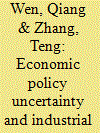|
|
|
Sort Order |
|
|
|
Items / Page
|
|
|
|
|
|
|
| Srl | Item |
| 1 |
ID:
187821


|
|
|
|
|
| Summary/Abstract |
This paper explores the effect of economic policy uncertainty (EPU) on industrial pollution using China's real-time pollution data and a novel news-based EPU index constructed by Davis, Liu, and Sheng (2019). Empirical results suggest that EPU can significantly promote sulfur dioxide (SO2) readings in cities experiencing higher ex-ante fiscal pressure, and this effect is more profound during the daytime. Given that SO2 is the main contributor to industrial pollution, and local governments have less incentive to monitor illegal pollutant discharges during the nighttime period, our findings indicate that rising EPU will harm the environment by motivating local authorities to reduce environmental supervision and thus increase industrial pollution. We also find that promoting regional innovation and strengthening external environmental regulations can mitigate the pollution effect of economic policy uncertainty.
|
|
|
|
|
|
|
|
|
|
|
|
|
|
|
|
| 2 |
ID:
187934


|
|
|
|
|
| Summary/Abstract |
State–business relations are important in studying economic restructuring and technological development in emerging industries. Classic debates have centered on a state- or business-centric model to spur innovation. Designated by the Chinese state as a region of innovation, the Guangdong-Hong Kong-Macau Greater Bay Area (GBA) has seen the rise of intensive state–business interactions. Our investigation of the National Enterprise Technology Center accreditation policy in the GBA reveals features distinguishing state–business interactions in regional innovation. These interactions are dynamic in the sense that the state and businesses, new technology companies in our case, co-determine and co-constitute policy implementation. Moreover, these interactions are hierarchically differentiated, with their forms and significance varying with the particular level of government involved because each level is accorded capacities and responsibilities of different political-economic importance. We propose that the multi-level governance (MLG) model provides a new and useful perspective for understanding such dynamics. Our results showed that each level of government interacted with technology companies by adopting different strategies. At the same time, businesses adapted their activities with different levels of government to foster partnerships for technological advancement.
|
|
|
|
|
|
|
|
|
|
|
|
|
|
|
|
| 3 |
ID:
166410


|
|
|
|
|
| Summary/Abstract |
Market demand is an important driver for inducing innovation, with many empirical studies supporting the demand-induced innovation hypothesis. Critiques of such studies, however, emphasize that new empirical evidence that can address existing empirical challenges is needed. Furthermore, existing literature disagrees about whether the locus of demand-pull policy matters. In this paper, we use empirical evidence from the distributed solar photovoltaic (PV) market in China to address the following questions: (1) Is there evidence of demand-induced innovation? (2) Does the effect of local demand-pull policy differ from the effect of non-local demand-pull policy on demand-induced innovation? To address these questions, we develop and analyze an original database of PV balance-of-system (BOS) patents in the distributed PV market filed between 2005 and 2014 in China. Our results support the demand-induced innovation hypothesis and suggest that only local demand significantly induces PV BOS innovations in the distributed PV market in China. The different effects of local demand and non-local demand emphasize the importance of local markets and local policies, lending some support to bottom-up approaches to clean energy governance.
|
|
|
|
|
|
|
|
|
|
|
|
|
|
|
|
| 4 |
ID:
166732


|
|
|
|
|
| Summary/Abstract |
Innovation-driven, energy consumption structure optimisation is crucial in developing countries. China, as a typical developing country, has been shifting its economic development model from a traditional approach to innovation-driven, high-quality development. We select nine resource-based regions in China as our research subject and employ a varying coefficient panel model and a Hansen panel threshold model to quantify the marginal and threshold effects of innovation capacity in optimising energy consumption structure. The results indicate that the overall energy consumption structure index for the analysed regions is 0.563, revealing that the structure is rather low and regional economic development relies mainly on low-ranked energy. Astonishingly, the marginal effect reflects obvious heterogeneity: a positive effect in Sichuan (−0.208), Yunnan (−0.207), and Xinjiang (−0.431); nearly no effect in Chongqing, Gansu, and Qinghai; and a negative effect in Guangxi (0.104), Shaanxi (0.244), and Ningxia (1.282). In previous studies, such negative effects have been totally ignored. Further, there are double thresholds and a unique driving mechanism, namely, ‘negative driving → strong positive driving → weak positive driving’. Interestingly, below the first threshold, improvement in innovation will lead to energy consumption structure degradation. Current policies, such as introducing extensive talent, are not feasible for all resource-based regions. The concerns of policy making for the three different threshold intervals should be: upgrading industrial structures, optimising the structure of human resources, and preventing ‘brain drain’, respectively.
|
|
|
|
|
|
|
|
|
|
|
|
|
|
|
|
|
|
|
|
|